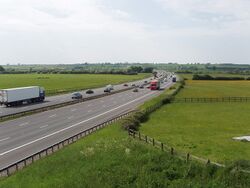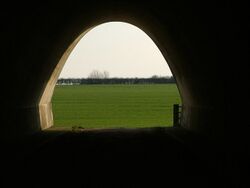Unbuilt Services On The M40
For a list of current service areas on the M40, see Services on the M40.
The M40 is a product of two eras. There is the 1970s road broadly between London and Oxford, and the 1991 road between Oxford and Birmingham.
The difference between the two - other than 20 years and two totally different political attitude - was that when the M40 only ran to Oxford it was more of a commuter motorway, isolated from any other motorways while providing relief for High Wycombe and the villages along the A40.
The Oxford Road
The road between London and Oxford (actually just from Uxbridge to Wheatley) had one designated service area, Abbey Barns. It is named after Abbey Barn Farm.
Positioned between J3 and J4, Abbey Barns had four ghost slips provided as part of the original construction of the road, which was built in 1969. The land was not purchased, but its completion was expected to be timed to match the completion of the M40 to Wheatley, which happened in 1974.
Progress on Abbey Barns was scheduled for January 1970, and then deferred because of the number of service areas already being planned. The site was eventually opened to bids in 1973, describing a 24 acre site that required at least £700,000 be invested in it (around £7million in 2025). It could be developed as one site or two, with a footbridge being provided, as well as a connection to the local road network.
No developers were interested. This had been happening a lot, and there was nothing they could do. Government policy was later updated to state that short motorways didn't need service areas, and planners "weren't sure" if the M40 even needed one. Instead two large lay-bys with toilets and payphones were built on the A40 Wheatley Bypass, which would act as the first place to stop for drivers leaving the motorway.
Unusually, the ghost slips here have not been maintained, and are now in an extremely poor state of repair.
Abbey Barns Again
After the plan to use Abbey Barns was postponed, further environmental concerns were raised which made building a service area here more unlikely. Additionally, it's understood that changes at the local authority in 1974 caused them to become opposed to the development.
Shell attempted to buy the land at Abbey Barns and win planning permission privately, which did not work. BP later tried the same.
After the Abbey Barns plan fell apart, there was brief mention of a "High Wycombe services" that could open in 1980, but with no location specified. By 1977, it was then stated that the preferred location was "Park Lane" (west of J4), with a footnote that Hedgerley or Abbey Barns may be used instead. None of these were pursued.
M40 Extension
The M40 between Oxford and Birmingham was one of the last major motorways in the UK. As a result, the planning process was much more contentious than when the early motorways were being drawn in the 1960s.
Of interest to us is the battle between counties over where the service stations would be. Oxfordshire County Council insisted that there should only be one motorway service area in Oxfordshire, and that M40 J10 would be the best place for it. The Department of Transport agreed with Oxfordshire's suggestion of J10, and in July 1986 the DoT put the 'M40 Policy' in writing.
The DoT had also been looking at "near Chesterton or Gaydon", a search that led to Barn Hill, which would open as Warwick services. Warwick's location was chosen because of its proximity to sites planned along the M42. A public inquiry was held in 1989, and residents objected to the proposal.
When the M40 opened in 1991, neither of these sites were ready, so emergency toilet facilities were provided at several junctions along the way. Famously, this formed the longest motorway in Britain without any service areas, forming part of a 230-mile route between Folkestone and Telford that had nowhere to stop. This issue would be raised frequently in the media, while signs like the one at Tetsworth which said "EMERGENCY WC 20 miles" attracted scorn.
One of many reasons for the delay was the fallout from the High Court case over Clacket Lane, which had criticised the Department's procedures, causing them to put all other proposals on hold for a time.
The Third Amigo

While there was going to be a whole new section of motorway with new service areas, the issues on the original road remained unresolved.
Following informal advice from Wycombe District Council, in 1986 the Department of Transport formally announced that they were going to be building Stokenchurch services at M40 J5. When the plan became public knowledge, many residents objected, prompting Wycombe District Council to announce their opposition and the local MP to launch a campaign against it.
In 1987 the Department of Transport commissioned a study to examine 15 other possible sites on the M40.
As a result of that study, 1989 the Department of Transport confirmed their intention to build Tetsworth services, between J6 and J7. It was chosen because of its "pleasant setting", and minimal impact on the community.
615 car parking spaces would have been provided on each side of the motorway, plus 125 HGV spaces, 33 coach spaces and 33 caravan spaces. It was described in the press as "Britain's biggest service station". Some of those spaces would be covered up as they weren't expected to be needed until 2008.
A public inquiry was held regarding Tetsworth in 1990, which ultimately led to planning permission being refused in 1991. Oxfordshire County Council had shared their "dismay" at the scheme, as they had been clear that they only wanted one service area in their county. The parish council were especially opposed to the idea, and concerned that the rear access would be used by too many vehicles.
The ill feeling at Tetsworth was partly down to its timing. The very day before the Department of Transport formally announced their intention to build a motorway service area here, the plan to build Stone Bassett new town on an adjacent field was rejected following an objection from the Department of Transport. Residents had moved from one battle to another, and they accused the Department of Transport of being "underhand" by not mentioning their own plans for this area.
After this the Department of Transport washed their hands of situation completely. In 1992, the government officially moved responsibility for planning new service areas from the DoT to the private sector. The DoT's failure to provide new service areas on the M40 was the main reason given, with the government arguing that the DoT were spending too much time and money dealing with planning issues.
Warwick and Cherwell Valley still weren't built, but the documents had been signed with Mobil and Esso so they would be going ahead as planned. One press release listed unfinished DoT projects that the private sector were encouraged to pick up, and it included a vague entry titled "M40 South". In truth, with Tetsworth rejected, there was no progress here at all and the private sector would be starting afresh.
In one respect that plan worked. A large number of planning requests for new service areas on the M40 were submitted, which led to a public inquiry in 1996. Once again Oxfordshire and Buckinghamshire were arguing over who should have the indignity of having a service station in their county.
The planning inquiry ruled in favour of building Oxford, precisely because it would leave space for a fourth service area to be built.
Fourth Arrival
The 1996 public inquiry had deliberately left a large gap at the bottom of the M40. Two rival planning applications were submitted to address it: Burtley Wood and Hedgerley. These were considered alongside a number of planning applications on the M25 in the 2002 public inquiry.
This concluded that Burtley Wood should be built, which opened as Beaconsfield.
Private Proposals

Since 1992, developers have been solely responsible for coming up with their own proposals for new motorway services. This led to an increase in proposals, but they are normally clustered around the same area and most are quickly ruled out.
Some of the new motorway services once planned for the M40 we have uncovered include:
| Place | Location | Proposed | Resolved | Outcome | Notes |
|---|---|---|---|---|---|
| Tetsworth | J6-7 | 1971 | 1971 | Refused. | Planned by Shell and BP. Not related to later DoT plans, and went against DoE policy at the time. |
| Longbridge | J15 (south side) | 1981 | 1989 | Refused on appeal. | Planned by Esso. Taken to public inquiry. DoT statement said the roundabout didn't have enough capacity. Opposed by Warwick District Council. |
| Gaydon | J12 (south side) | 1986 | 1995 | Refused. | Planned by Blue Boar. Taken to 1989 public inquiry. Refused because the DoT's Barn Hill was a better site. In 1995, a report in The Guardian claimed that nine different developers were proposing services in the vicinity of M40 J11 and J12, but this may have been inaccurate. |
| Booker | J4-5 (Park Lane) | 1987 | 1996 | Refused. | Planned by Mobil separate to DoT plans. Utilised existing subway. Used in 1991 Tetsworth public inquiry. Taken to 1996 public inquiry. Refused because it's too close to J4 and too far from Cherwell Valley. |
| Abbey Barns | J3-4 | 1988 | 1989 | Refused. | Planned by BP. Refused because it went against the DoT's 'M40 Policy'. DoT had previously ruled out building here. |
| Stokenchurch (Hill Farm) | J5A (north side) | 1992 | 1996 | Refused. | Planned by Shell. Involved construction of new J5, with new link road, and roundabout serving service area. Taken to 1996 public inquiry. |
| Waterstock | J8A (north-east corner) | 1993 | 1996 | Refused. | Planned by Wyatt Bros. Taken to 1996 public inquiry. Wyatt were keen to point out what they had proposed was "not to create a motorway service area in the familiar sense", an arty phrase that caused confusion, so they then had to clarify that what they had proposed was in fact a typical service area. |
| Oxford (Wheatley) | J8A (south-west corner) | 1993 | 1998 | Built. | Planned by Welcome Break. Taken to 1996 public inquiry. Survived company's Granada takeover. Involved building new slip roads. |
| Lewknor | J6 (east side) | 1994 | 1996 | Refused. | Planned by Extra and Texaco. Three locations were submitted, including west of the junction with new slip roads, and north-east of the junction with a new roundabout. Taken to 1996 public inquiry. |
| Tetsworth | J6-7 (Manor Road) | 1994 | 1996 | Refused. | Planned by Margram and Lawlor Land Plc in exact place that DoT had been refused, albeit taking up less land. Taken to 1996 public inquiry. |
| Hedgerley (Mount Hill) | J1-2 (Hedgerley Lane) | 1994 | 2005 | Refused. | Planned by Hallam Land Management, Oakstead Developments Ltd and Margram. Initially withdrawn because of confusion over M40 widening works. Oakstead plan was westbound only. Hallam plan was westbound only, with a flyover and looped slip roads. Taken to 2002 public inquiry. Refused because Burtley Wood was less environmentally damaging. |
| Beaconsfield (Burtley Wood) | J2 (south-east corner) | 1994 | 2009 | Built. | Taken to 2002 public inquiry, where it was declared to be less damaging than Hedgerley. |
| Banbury | J11 (north-east corner) | 2016 | 2018 | Refused. | Planned by Euro Garages. Was a combined employment area and service station. Not clear if they would have applied for signs on the M40. Described as a "monstrosity" by the District Council; opposed by the County Council. Eventually resubmitted as an employment area only. |